thistlemagnate
Member
- Joined
- Aug 24, 2008
- Messages
- 25
A google for "tractor rolled killed" finds several million hits. ROPS (Roll Over Protection System, which is a big metal frame over the tractor seat) and a buckled seatbelt are a requirement if on anything but dead flat flat and no load in the FEL (Front End Loader). You can flip a tractor on flat ground real quick if the FEL is high with a load and you take a corner in anything but one of the lowest gears. I can't imagine an inclinometer would be of any use at all, just a distraction that gives a false sense of security.
We live on the bench of a steep canyon wall. Got a Branson 3510i here, use it on uneven and occasionally steep terrain. I once had two wheels off the ground, moving very slowly when taking a 1500 lb pallet off a high truck bed with the FEL, on flat ground. A front wheel found a gopher hole. You want your hand near the FEL hydraulics whenever lifting something heavy, ready to drop it. Move slowly when you have a load. On steep terrain, you want to be going straight up or down, not sideways. If on loose material, be aware that you might slip to a sideways orientation.
After years of nearly killing myself, I finally figured out that the wheels were configured for flatlanders, going for minimum tractor width. On the rears of this Branson, I can place the inner steel wheel on either side of the outer steel wheel, and I can spin the inner wheel 180 degrees This gives four different possible widths across the two rear tires when mounted on the tractor to choose from. In some configurations you will need to swap the left and right tires to get the tread oriented for maximum traction when going forward, and the schrader air valve will then be on the inside of the tire, not an issue. I went for maximum width and have yet to catch air again, far far more stable than the stock configuration. You can buy spacers to fit between the hub and the wheel to get the front tires back in the same tracks as the rears, though I haven't bothered yet.
Turf tires might give a slightly wider stance than ag tires, be able to carry a heavier load because of the greater area in contact with the dirt, less soil compaction. I use ag (agricultural tread) tires because I need that traction in snow and mud, but am considering going to wider tires and using chains when I need the traction.
Edit: Some people think they are better off without a buckled seatbelt, planning to somehow jump clear when things go south. If they did manage to jump in the split second when a tractor rolls, they would most likely be jumping right into the spot that the tractor will be rolling over the top of.
We live on the bench of a steep canyon wall. Got a Branson 3510i here, use it on uneven and occasionally steep terrain. I once had two wheels off the ground, moving very slowly when taking a 1500 lb pallet off a high truck bed with the FEL, on flat ground. A front wheel found a gopher hole. You want your hand near the FEL hydraulics whenever lifting something heavy, ready to drop it. Move slowly when you have a load. On steep terrain, you want to be going straight up or down, not sideways. If on loose material, be aware that you might slip to a sideways orientation.
After years of nearly killing myself, I finally figured out that the wheels were configured for flatlanders, going for minimum tractor width. On the rears of this Branson, I can place the inner steel wheel on either side of the outer steel wheel, and I can spin the inner wheel 180 degrees This gives four different possible widths across the two rear tires when mounted on the tractor to choose from. In some configurations you will need to swap the left and right tires to get the tread oriented for maximum traction when going forward, and the schrader air valve will then be on the inside of the tire, not an issue. I went for maximum width and have yet to catch air again, far far more stable than the stock configuration. You can buy spacers to fit between the hub and the wheel to get the front tires back in the same tracks as the rears, though I haven't bothered yet.
Turf tires might give a slightly wider stance than ag tires, be able to carry a heavier load because of the greater area in contact with the dirt, less soil compaction. I use ag (agricultural tread) tires because I need that traction in snow and mud, but am considering going to wider tires and using chains when I need the traction.
Edit: Some people think they are better off without a buckled seatbelt, planning to somehow jump clear when things go south. If they did manage to jump in the split second when a tractor rolls, they would most likely be jumping right into the spot that the tractor will be rolling over the top of.
Last edited:

